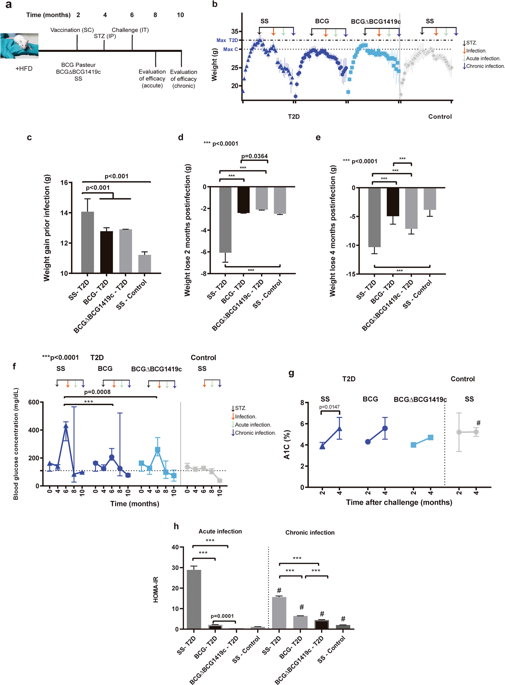npj Vaccines ( IF 9.2 ) Pub Date : 2020-03-12 , DOI: 10.1038/s41541-020-0169-6 Cristian Alfredo Segura-Cerda 1, 2 , Brenda Marquina-Castillo 3 , Vasti Lozano-Ordaz 3 , Dulce Mata-Espinosa 3 , Jorge Alberto Barrios-Payán 3 , Manuel O López-Torres 3 , Michel de Jesús Aceves-Sánchez 2 , Helle Bielefeldt-Ohmann 4 , Rogelio Hernández-Pando 3 , Mario Alberto Flores-Valdez 2

|
Comorbidity between Tuberculosis (TB) and type 2 diabetes (T2D) is one of the greatest contributors to the spread of Mycobacterium tuberculosis (M. tuberculosis) in low- and middle-income countries. T2D compromises key steps of immune responses against M. tuberculosis and it might affect the protection afforded by vaccine candidates against TB. We compared the protection and immune response afforded by the BCGΔBCG1419c vaccine candidate versus that of wild-type BCG in mice with T2D. Vaccination with both BCGΔBCG1419c, BCG or infection with M. tuberculosis reduced weight loss, hyperglycemia, and insulin resistance during T2D progression, suggesting that metabolic changes affecting these parameters were affected by mycobacteria. For control of acute TB, and compared with non-vaccinated controls, BCG showed a dominant T CD4+ response whereas BCGΔBCG1419c showed a dominant T CD8+/B lymphocyte response. Moreover, BCG maintained an increased response in lung cells via IFN-γ, TNF-α, and IL-4, while BCGΔBCG1419c increased IFN-γ but reduced IL-4 production. As for chronic TB, and compared with non-vaccinated controls, both BCG strains had a predominant presence of T CD4+ lymphocytes. In counterpart, BCGΔBCG1419c led to increased presence of dendritic cells and an increased production of IL-1 β. Overall, while BCG effectively reduced pneumonia in acute infection, it failed to reduce it in chronic infection, whereas we hypothesize that increased production of IL-1 β induced by BCGΔBCG1419c contributed to reduced pneumonia and alveolitis in chronic TB. Our results show that BCG and BCGΔBCG1419c protect T2D mice against TB via different participation of T and B lymphocytes, dendritic cells, and pro-inflammatory cytokines.
中文翻译:

BCG 和 BCGΔBCG1419c 通过 T 和 B 淋巴细胞、树突状细胞和促炎细胞因子的不同参与保护 2 型糖尿病小鼠免受结核病侵害
结核病 (TB) 和 2 型糖尿病 (T2D) 之间的合并症是导致结核分枝杆菌 (M.tuberculosis)在低收入和中等收入国家传播的最大因素之一。T2D 会损害针对结核分枝杆菌的免疫反应的关键步骤,并且可能会影响候选疫苗提供的针对结核病的保护。我们比较了 BCGΔBCG1419c 候选疫苗与野生型 BCG 在 T2D 小鼠中提供的保护和免疫反应。接种 BCGΔBCG1419c、BCG 或感染结核分枝杆菌T2D 进展期间体重减轻、高血糖和胰岛素抵抗减少,表明影响这些参数的代谢变化受到分枝杆菌的影响。对于急性结核病的控制,与未接种疫苗的对照组相比,BCG 显示出显性的 T CD4 +反应,而 BCGΔBCG1419c 显示出显性的 T CD8 + /B 淋巴细胞反应。此外,BCG 通过 IFN-γ、TNF-α 和 IL-4 维持肺细胞中增加的反应,而 BCGΔBCG1419c 增加了 IFN-γ 但减少了 IL-4 的产生。至于慢性结核病,与未接种疫苗的对照组相比,两种 BCG 菌株均主要存在 T CD4 +淋巴细胞。相反,BCGΔBCG1419c 导致树突细胞的存在增加和 IL-1 β 的产生增加。总体而言,虽然 BCG 有效减少了急性感染中的肺炎,但未能减少慢性感染中的肺炎,而我们假设 BCGΔBCG1419c 诱导的 IL-1 β 产生增加有助于减少慢性 TB 中的肺炎和肺泡炎。我们的结果表明,BCG 和 BCGΔBCG1419c 通过 T 和 B 淋巴细胞、树突状细胞和促炎细胞因子的不同参与来保护 T2D 小鼠免受结核病的侵害。


























 京公网安备 11010802027423号
京公网安备 11010802027423号